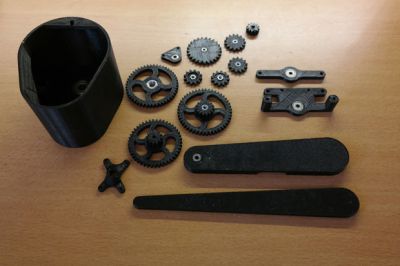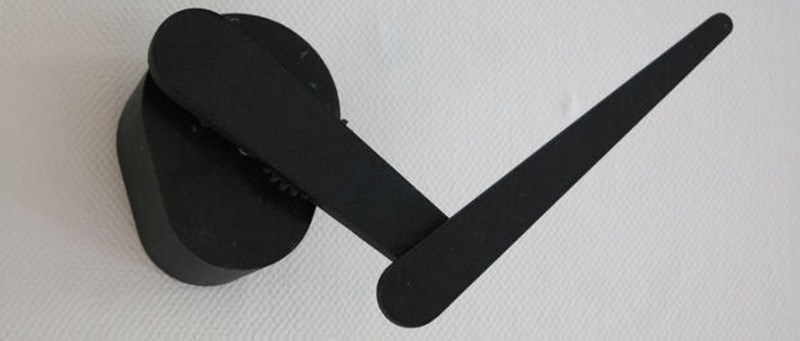We see a lot of clocks here on Hackaday. Some make it easy to tell the time, others are more cryptic. [dragonator] has done something that is so simple, we are surprised it isn’t more common. In a typical mechanical hand clock the minute and hour hands rotate around the same axis. [dragonator] decided to take the minute hand and move it out to the tip of the hour hand.
It works because of a gear system hidden behind the thick hour hand. As the hour hand turns, the gear system rotates, the last gear of which is connected to the minute hand. Since the minute hand rotates 12 times for every one revolution of the hour hand, the gear ratio can easily be calculated.
 The 3D printed parts were designed by [dragonator] himself. All of the design files are available here for anyone who wants to build one of these neat clocks.
The 3D printed parts were designed by [dragonator] himself. All of the design files are available here for anyone who wants to build one of these neat clocks.
The clock uses a Trinket microcontroller board to keep track of the time and to send step signals to a StepStick that drives a NEMA 17 stepper motor. There is no on-board battery power for this clock, 9-12vdc comes in via a wall wart and is stepped down to 5v by the micro controller’s regulator. Even still, this is a great project that makes it fun to watch time pass, check the video out after the break.
















Genius.
Really, if you’ve ever looked at how a mechanical watch or clock function, this makes absolute perfect sense. The mainspring dumps its energy into the hour wheel, which turns the minute wheel, which turns the seconds wheel, which is actually timed by the escapement (yeah, I know the wheels are actually numbered, but for illustrative purposes I have named them by the hands to which they are attached, and have left out extraneous wheels). So, imparting motion to the hour hand and stepping it up in “speed” to the minute hand is more similar to mechanical timepieces.
I am kinda impressed that he could get enough torque out of a small motor to pull off a 1:60 ratio, though. I suppose the metal I see in the center of the gears are bushings or bearings of some sort.
Ahh, he does use bearings, but the gears have nuts pressed into them for attachment to their corresponding “pinions”.
Actually, the hour-to-minute ratio is just 12:1 (or 24:1). Every twelve hours the hour hand makes one full rotation, while the minute hand makes twelve. The second hand has a 60:1 ratio. I got caught on that as well when I was working on a mechanical Lego clock a while back… I did a whole lot of work getting a 60:1 ratio and it was a few days or maybe weeks before I realized it was wrong.
Sorry, minute to hour, or reverse my ratios (1:12, 1:60). The logic is solid though.
Needs an RGB led on the end of the minute hand and a long-exposure photo taken with the clock running fast and changing colours as the time progresses. That would look pretty cool – like a time domain spirograph :)
I thought exactly the same ;)
Why does everyone think that, must just be the cool motion.
In the end, we all just wanna see something blink ;)
Haha, I went further than that and thought of a small projector at the end of each hand that projects the number on the wall next to it. Only then I’d be able to tell time with this :))
Looks like a drunken WiFi antenne to me :D
Clever idea :)
The article says the ratio is 1:12 but my calculations make it 1:60. BUT it would be less again because the 12:00 position of the minute hand will vary depending on the position of the hour hand.
1:12 is right. Hour hand goes full circle in 12 hours -> the minute hand needs to have gone around 12 times.
But 1:12*60 is probably why he doesn’t have a second hand.
I am not sure about the ratio either. Maybe a digital clock readout on the video alongside the clock would answer some questions. For example when both arms are directly pointed at say 6 … Is it 6:30 or 6? In other words is the minute hand related to the clock face or the hour arm. If it is to the clock face it would be somewhat difficult to read this clock. If it is to the hand then it seems like there would be 5 extra minutes to each hour based on 1:60 gearing. Perhaps I just need to know how to read it.
Awesome project. Now I desperately want to see a second hand whizzing around the minute hand.
I would think it’s the same as a conventional clock: both hands are *never* pointing directly at the 6. At 5:30, the hour hand is just to the right of 6, and 6:30 it’s just to the left.
It looks like the motion of the hand is driven by rotation about a center sun gear, so it’s not really rotating relative to the hour hand. That way you can get away with 1:12 instead of 1:11.
Now, I would like to see it done other way around.
Isn’t a NEMA 17 stepper a total overkill?
It might be? Why don’t you do some torque calculations and let us know? He may have planned to do a direct drive or something at first also then changed paths along the way and did reduction, he might have had a spare motor just around, who knows!
Now for a spiral shaped line to track the time.
Really needs a second hand thrown on the end…
And a 1/100 sec. hand at the end of the second hand. (c:
Anyone selling a kit?
This is fantastic! Great project.
Add the clock face and I’ll be impressed.
Very cool. One small suggestion: use white color for the base. It will make it easier to read.
Cool! Though I’d just use 2 servos – I’m not any good with gears and mechanics =)
To what end?
To be able to tell the time, sweety.
https://www.youtube.com/watch?v=QNhkxXdAeGY
I independently invented this a few years ago after playing around with the mechanism from a salad spinner. I didn’t actually build one, though, and this one has a nice, minimalistic aesthetic. I approve ;)
Yeah, it’s ingenious and all, “art”, but there’s no dial. If there was one, IT would have to move weirdly too, otherwise the hands would be all over the place. In lieu of that, have a rack mounted on the wall next to it filled with golf balls. At each hour, the hand would hit a ball, which would roll down a track, which would trigger a cigarette lighter, which would burn a string, which would release a suspended weight onto a startled monkey that would hold up the right number of fingers to indicate the time. Then the money would put the golf ball back and replace the string. It could even wear a little hat and dance the meringue while doing so.
I once had a software version of this on the Android s6. Now I can’t find it! Yours? Do you know how I can get access this…. as I was st00pid to delete it! It’s a BRILLIANT concept!
Kudos.